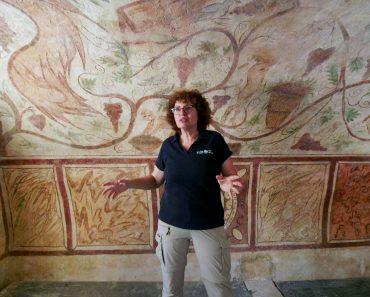
Anyone who has enjoyed a cold frappe on a summer day in Athens has probably noticed fans spraying a refreshing mist that cools the air. This cooling mist, often a welcome relief, isn’t a modern invention.
The origin of taverna mist can be traced back to antiquity when the Romans first developed the mist systems. But what connects ancient Rome’s amphitheaters to today’s outdoor cafes?
Sparsiones in ancient Rome: The origins of taverna mist
In ancient Rome, public comfort was a priority, especially in the Mediterranean heat. The Romans, famous for their public shows and grand buildings, developed a practice known as sparsiones to keep audiences comfortable in their amphitheaters.
This practice is the origin of taverna mist, as it involved spraying the crowd with a cooling mist of water mixed with fragrant oils. It addressed both the discomfort of the heat and unpleasant smells from large crowds and events in the arena.
The sparsiones served two purposes: cooling the spectators and masking the smells from the crowd, animals, and blood from gladiatorial combat. In large spaces like the Colosseum, where tens of thousands gathered, managing heat and odors was crucial.
The Romans, who loved luxury, often added scents like balsam or saffron to the water, blending practicality with elegance. This practice laid the groundwork for what would later become the modern taverna mist.
Evidence of early cooling mists
Pliny the Elder, a Roman writer, provides early references to this practice in his work The Natural History. He describes how these mists cooled the crowd and created a more pleasant atmosphere by spreading fragrant oils into the air.
This mix of practicality and luxury shows the Roman commitment to enhancing sensory experiences in public spaces, further linking the origin of taverna mist to ancient Roman ingenuity.
While Pliny provides insight into the use of scented mists, the exact methods of delivering sparsiones are not clear. Some scholars believe attendants manually sprayed the mists using handheld devices, while others believe they used more complex systems with pipes and nozzles.
Some even speculate that the term sparsiones might refer to the distribution of other items, like fruit or coins, to surprise the audience.
Refreshing propaganda
Isabelle Simon’s 2008 study on Roman liberalitas provides valuable insights into the broader meanings of sparsiones. According to Simon, these mists were more than just a practical way to cool people down. They symbolized the emperor’s generosity and care for the people.
The use of cooling mists in both ancient and modern settings reflects broader societal values. In Rome, sparsiones were not just about physical comfort but also a public statement of power and kindness. Cooling the crowd and perfuming the air showcased the emperor’s wealth and generosity.
Isabelle Simon’s research emphasizes that these acts of generosity reinforced the emperor’s role as a provider, showing his power in a clear way. The public nature of these acts meant large crowds witnessed them, making them effective tools for propaganda and public relations.
Today, while the political significance may have evaporated, the social impact of cooling mists remains. These systems contribute to the culture of hospitality, central to Greek culture from antiquity.






